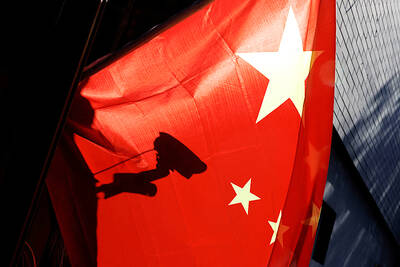Chinese Nationalist Party (KMT) presumptive presidential nominee Hung Hsiu-chu (洪秀柱) said her “one China, same interpretation” formula aims to have China recognize the existence of “the government of the Republic of China [ROC], not the existence of the ROC, otherwise it would become a ‘two-state theory.’”
Hung was interviewed on a TV talk show late on Thursday in which the host questioned her about the implications of her “one China, same interpretation” cross-strait proposal that calls for China to recognize the ROC.
“If we want China to recognize the ROC, but at the same time it is impossible for them to deny the People’s Republic of China [PRC], wouldn’t that be suggesting there are two Chinas?” the host asked.
“You have completely misunderstood [my policy],” Hung said. “It is the existence of the ROC government [that we want Beijing to recognize]. And we would also recognize the existence of the PRC government.”
“We have overlapping sovereignty claims, but are two separate governing bodies. The logic is clear and simple,” Hung said. “Taiwanese independence, if possible, would be good as well, but it is simply not possible. Changing the Constitution would incur strong opposition from both [China] and the US.”
Regarding the difficulty of obtaining the recognition of the ROC government by the PRC, which the host said had not been achieved so many years after the efforts of late Straits Exchange Foundation chairman Koo Chen-fu (辜振甫), Hung said that it should not be given up just because it is hard.
“After so many interactions and signed agreements, the fact we have still failed to achieve what we want shows there still is a lack of mutual trust between the two sides of the Taiwan Strait,” she said. “It shows that we have come to face a bottleneck in the structure built up based on the ‘1992 consensus,’ and it should be eased.”
“However, we would not say the step [of easing the bottleneck] should not be taken simply because it is difficult,” Hung said.
In response to media queries after the interview, Hung said that although the sovereignty claims of the two governments overlap, “I cannot [ask the PRC to recognize] the existence of the ROC, as that entails the [simultaneous existence] of the PRC and the ROC, which would become a ‘two-state theory.’”
Separately, during an interview with Chinese Television System aired on Thursday night and last night, President Ma Ying-jeou (馬英九) endorsed Hung’s “one China, same interpretation” formula, which he said was “almost the same as my proposal.”
The “one China, same interpretation” proposal did not go beyond “one China, different interpretations,” known as the so-called “1992 consensus,” Ma said, referring to a supposed tacit understanding between the KMT and Beijing that both sides agree there is “one China,” with each side having its own interpretation of what “China” means.
“The ‘one China, same interpretation’ proposal adheres to the ‘one China’ principle and she interprets China as the ROC, as I do,” he said.
After Hung’s “one China, same interpretation” was put forward, the US did not send its representative to meet with Hung like some other countries did, Ma said.
“That meant that [the US] is not worried about her policy,” Ma said.
Ma is expected to meet with some US officials, lawmakers and academics during transit stops in Boston and Los Angeles on his way to visit three of the nation’s allies in Central America and the Caribbean, which starts on Saturday next week.
“I will explain [Hung’s policy] to the US should they ask me about it,” Ma said.
Ma said that after he returns to Taiwan on July 18, he would attend the KMT’s national congress, which is expected to confirm Hung’s nomination.
“I don’t see any possibility that her nomination would fail to pass the national congress,” Ma said.

A magnitude 7.0 earthquake struck off Yilan at 11:05pm yesterday, the Central Weather Administration (CWA) said. The epicenter was located at sea, about 32.3km east of Yilan County Hall, at a depth of 72.8km, CWA data showed There were no immediate reports of damage. The intensity of the quake, which gauges the actual effect of a seismic event, measured 4 in Yilan County area on Taiwan’s seven-tier intensity scale, the data showed. It measured 4 in other parts of eastern, northern and central Taiwan as well as Tainan, and 3 in Kaohsiung and Pingtung County, and 2 in Lienchiang and Penghu counties and 1

FOREIGN INTERFERENCE: Beijing would likely intensify public opinion warfare in next year’s local elections to prevent Lai from getting re-elected, the ‘Yomiuri Shimbun’ said Internal documents from a Chinese artificial intelligence (AI) company indicated that China has been using the technology to intervene in foreign elections, including propaganda targeting Taiwan’s local elections next year and presidential elections in 2028, a Japanese newspaper reported yesterday. The Institute of National Security of Vanderbilt University obtained nearly 400 pages of documents from GoLaxy, a company with ties to the Chinese government, and found evidence that it had apparently deployed sophisticated, AI-driven propaganda campaigns in Hong Kong and Taiwan to shape public opinion, the Yomiuri Shimbun reported. GoLaxy provides insights, situation analysis and public opinion-shaping technology by conducting network surveillance

Taiwan is gearing up to celebrate the New Year at events across the country, headlined by the annual countdown and Taipei 101 fireworks display at midnight. Many of the events are to be livesteamed online. See below for lineups and links: Taipei Taipei’s New Year’s Party 2026 is to begin at 7pm and run until 1am, with the theme “Sailing to the Future.” South Korean girl group KARA is headlining the concert at Taipei City Hall Plaza, with additional performances by Amber An (安心亞), Nick Chou (周湯豪), hip-hop trio Nine One One (玖壹壹), Bii (畢書盡), girl group Genblue (幻藍小熊) and more. The festivities are to

AFTERMATH: The Taipei City Government said it received 39 minor incident reports including gas leaks, water leaks and outages, and a damaged traffic signal A magnitude 7.0 earthquake struck off Taiwan’s northeastern coast late on Saturday, producing only two major aftershocks as of yesterday noon, the Central Weather Administration (CWA) said. The limited aftershocks contrast with last year’s major earthquake in Hualien County, as Saturday’s earthquake occurred at a greater depth in a subduction zone. Saturday’s earthquake struck at 11:05pm, with its hypocenter about 32.3km east of Yilan County Hall, at a depth of 72.8km. Shaking was felt in 17 administrative regions north of Tainan and in eastern Taiwan, reaching intensity level 4 on Taiwan’s seven-tier seismic scale, the CWA said. In Hualien, the